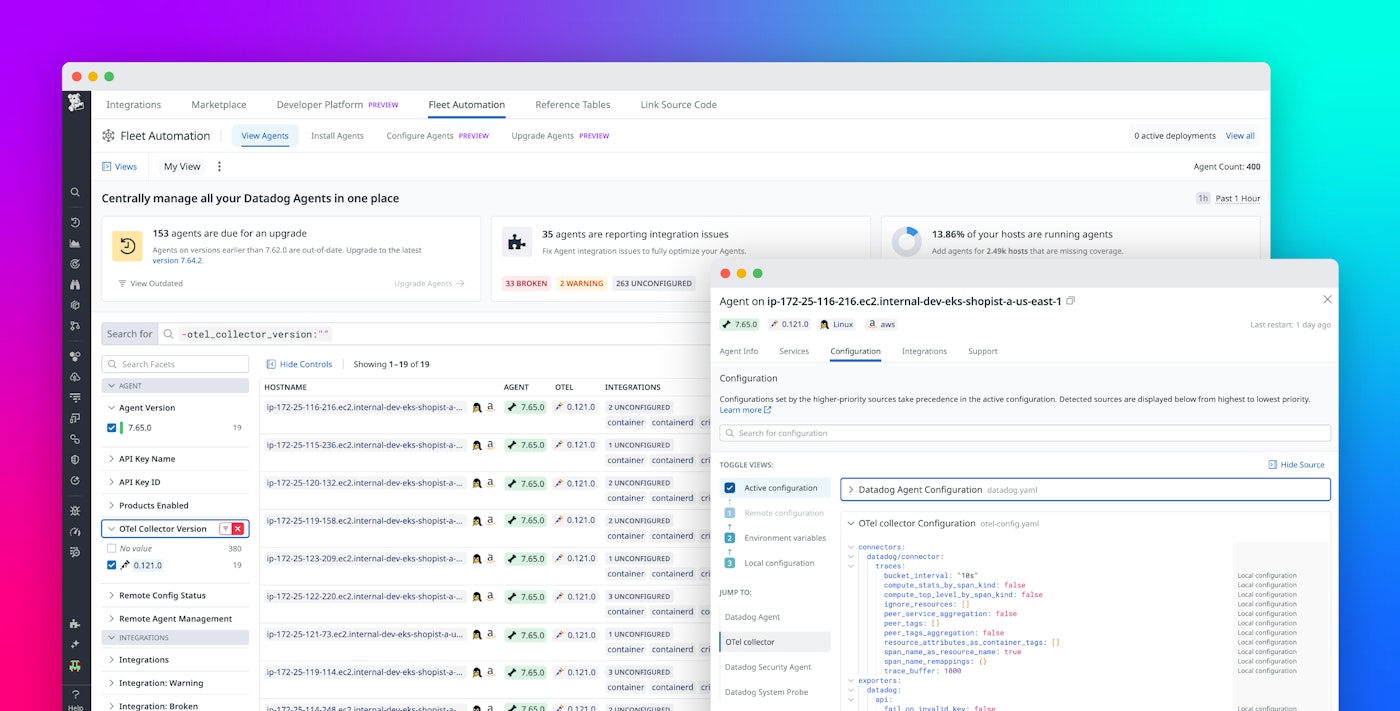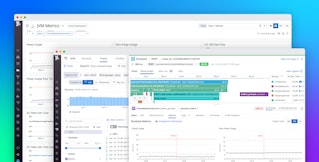
Lutao Xie

Evan Pandya
OpenTelemetry (OTel) is an open source observability framework that provides a standardized approach to collect, process, and export telemetry data across distributed systems. It defines specifications such as the OpenTelemetry Protocol (OTLP) by outlining how telemetry data (e.g., traces, metrics, logs) should be captured, encoded, and transmitted in a vendor-neutral format. OTel provides a suite of tools—including APIs, SDKs, and the OTel Collector—that developers can use to instrument applications and collect telemetry in OTLP format.
At Datadog, we believe that OpenTelemetry provides the most value when it is combined with an interoperable observability backend. That is why we support W3C Trace Context and the OTel API in our SDKs, enabling vendor-neutral instrumentation of users’ applications and OTel standards within our APM ecosystem. As the OTel Collector community evolves, teams are looking to access more advanced observability features like Live Container Monitoring, Network Monitoring, eBPF-based Universal Service Monitoring and Workload Protection, and more. But teams using OTLP Ingest in the Datadog Agent couldn’t use the full OTel Collector flexibility to process and export OTLP data to multiple destinations. This created a tough trade-off: adopt OpenTelemetry’s flexibility or benefit from Datadog’s comprehensive monitoring, security, and automation features.
To take this interoperability between OTel and Datadog even further, the Datadog Distribution of the OTel Collector (DDOT Collector) provides an enterprise-ready, OTel-native Collector distribution that enables users to adopt OTel flexibility while taking full advantage of Datadog’s advanced features. Built as a native capability of the Datadog Agent, the DDOT Collector allows you to collect, process, and export OTLP telemetry to Datadog (or other destinations) by using OTel-native configurations and easily extend the Collector with custom OTel-compatible components to meet your unique observability needs. The DDOT Collector is secure, performant, and production-ready by default, and it is also fully manageable at scale with Datadog Fleet Automation, reducing operational overhead and accelerating issue resolution with one-click support ticket submission to Datadog’s global support team. By combining the flexibility of OTel with the comprehensiveness of the Datadog platform, the Datadog Agent with the DDOT Collector offers a unified experience for modern observability workflows in an all-in-one solution.
In this blog post, we will walk you through how you can:
- Extend the OTel Collector’s feature set with broader and deeper observability
- Simplify OTel Collector management at scale with Fleet Automation
- Confidently accelerate OTel adoption with enterprise-grade reliability, security, and support
Extend the OTel Collector’s feature set with broader and deeper observability
With the DDOT Collector, you gain immediate access to Datadog’s advanced observability features without giving up the OTel collector capabilities you rely on today. These features include our 850+ built-in integrations, Live Container Monitoring, Network Monitoring, eBPF-based Universal Service Monitoring and Workload Protection, and more—enabling deeper, broader, and more actionable insights across your infrastructure and applications. Simultaneously, you can collect telemetry in native OTLP format (via OTel receivers) and retain full control over your OTLP telemetry pipeline. The Collector’s rich processing and routing capabilities—through OTel processors and exporters—allows you to shape, transform, and direct your OTel observability data as needed.
For example, let’s say you want to monitor the health and performance of the applications running in your containerized environment. You can configure the DDOT Collector to supply OTLP metrics, traces, and logs from OTel-instrumented applications. At the same time, you can use Live Container Monitoring and the Kubernetes Orchestrator Explorer for end-to-end visibility across all resource types (clusters, pods, nodes) in real time—providing a multi-dimensional view of your workloads. The Datadog Agent automatically discovers new containers and services as they are created, helping you stay on top of your dynamic infrastructure. Because Datadog automatically correlates OTLP data with its native telemetry—enriching it with container, pod, and host metadata—you get unified visibility across your infrastructure and applications. This means you can inspect a container in real time, then seamlessly jump into the OTLP traces and logs emitted from the application running inside it—all without losing context or switching tools.
Simplify OTel Collector management at scale with Fleet Automation
While the OTel Collector provides greater data flexibility and control, managing large fleets of Collector configurations and deployments can be challenging. Teams often struggle with manual configuration updates, inconsistent telemetry pipelines, and troubleshooting issues across distributed environments, leading to operational overhead, delayed insights, and potential gaps in observability.
With Datadog Fleet Automation, you can remotely govern and manage your fleet of DDOT Collectors for visibility into your entire configuration, dependencies, and runtime environment, alongside Agent configurations. Additionally, Fleet Automation makes it easy to troubleshoot configuration issues for the embedded OTel Collector, the same way it does for the Datadog Agent. You can send a flare that automatically includes diagnostic information from within the Datadog app to create or update a support ticket without logging into the affected host.
Confidently accelerate OTel adoption with enterprise-grade reliability, security, and support
The DDOT Collector is an enterprise-ready, production-grade distribution of the OpenTelemetry Collector, designed to help you adopt and scale OpenTelemetry with confidence. Built as a native capability of the Datadog Agent, the DDOT Collector is secure, performant, and tested for quality assurance by default. It includes a curated set of OTel components selected and optimized for reliability, security, and performance when used with Datadog—delivering a solution you can trust to run reliably in any environment, without the uncertainty or overhead often associated with managing open source tooling.
To help maintain security and compliance, Datadog performs regular vulnerability scans, configuration analysis, and dependency checks on the Agent including the DDOT Collector. All common vulnerabilities and exposures (CVEs) are assessed and remediated in line with Datadog’s vulnerability management policy. Critical issues in DDOT components are treated with the same urgency as Agent updates, giving you timely and trusted fixes. You’ll also receive prompt Agent updates along with community-managed OTel Collector releases.
DDOT Collector users also benefit from Datadog’s global support team. As part of the Agent flare feature, users can submit support tickets via one click on the Fleet Automation page to escalate issues directly from their environment—accelerating the troubleshooting process and time to resolution with expert help.

Unify your OpenTelemetry and Datadog experience today
With the Datadog Distribution of the OpenTelemetry Collector (DDOT Collector), OTel users can combine vendor-neutral telemetry pipelines with Datadog’s advanced monitoring and security features, including Live Container Monitoring, Network Monitoring, eBPF-based Universal Service Monitoring and Workload Protection, and more. The DDOT Collector fully conforms to an OTel-defined distribution while remaining extensible: with full support for Bring Your OTel Component (BYOC) workflows, teams can extend the DDOT Collector with OTel-compatible components of their choice, enabling greater flexibility while benefiting from centralized Datadog Fleet Management.
Getting started is simple—if you’re new to OpenTelemetry, simply upgrade your Agent version to v7.65+ and enable the DDOT Collector via a single configuration flag. Teams already using the OTel Collector can directly pass their existing OTel configuration YAML file during the Agent installation via a Datadog Helm Chart or the Datadog Operator.
Check out our documentation for more details to start exploring Datadog’s hybrid observability capabilities. And if you’re new to Datadog, get started with a 14-day free trial.





